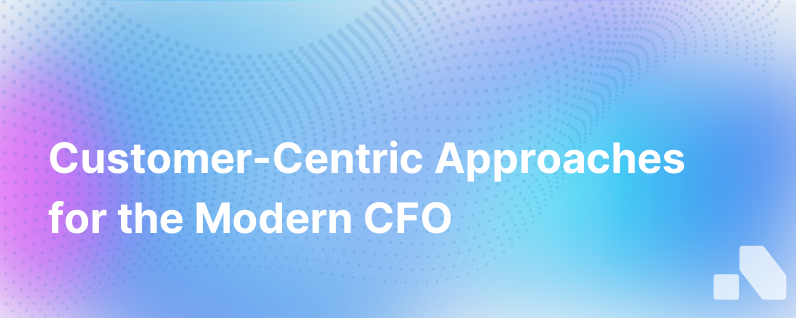
In an evolving business landscape, where customer satisfaction asserts its dominance as a pivotal growth catalyst, the role of the Chief Financial Officer (CFO) is undergoing a compelling transformation. Gone are the days when CFOs were solely stewards of a company’s financial health; they now find themselves at the helm of customer-centric strategies.
The newfound paradigm – the Customer-Centric CFO – is reshaping how companies chart their financial and customer experience roadmaps. Let’s dive deep into what it means to be a customer-centric CFO, why it matters significantly, the strategies involved, and the benefits derived from such an approach.
Customer-Centricity: The New Frontier for CFOs
Traditionally, CFOs focused on numbers, budgets, and financial outcomes. But as businesses recognize the importance of customer satisfaction as an engine for sustainable growth, CFOs are stepping into more strategic roles centered around the customer experience.
The core of a customer-centric CFO strategy is the alignment of financial planning and analysis with customer data. Optimally, this convergence aims at lowering costs, enhancing efficiency, and most importantly, boosting customer satisfaction and loyalty.
The Why: Importance of Customer-Centric CFOs
The importance of a customer-centric approach to finance is underscored by market demands and competitive dynamics. In today's market, where product and price differentiation are often slim, the customer experience can be a clear differentiator.
Engagement and retention are critical metrics for growth, and CFOs who understand customer behaviors and preferences are better equipped to drive business decisions that foster loyalty and drive revenue growth. They help bridge the gap between financial metrics and customer-centric key performance indicators (KPIs), ensuring that businesses do not merely survive but thrive by putting the customer first.
Furthermore, CFOs with a finger on the pulse of customer sentiment can more effectively anticipate market changes and adapt financial strategies proactively.
The How: Adopting a Customer-Centric Approach
-
Leverage Data Analytics: A data-driven approach allows CFOs to gain rich insights into customer behaviors and preferences. Integrating financial data with customer analytics enables CFOs to forecast trends, measure customer lifetime value, and assess the impacts of customer acquisition and retention on the bottom line.
-
Invest in Customer Success: Adoption of technologies and processes that enhance customer satisfaction can have a significant ROI. For example, automation tools that streamline billing and subscription management or investments in customer support and success teams can improve customer experiences dramatically.
-
Align Objectives Across Departments: Customer-centric CFOs foster collaboration between finance, marketing, sales, and support teams to ensure that customer experience is a shared objective. This alignment helps pinpoint where investments in customer experience can have the greatest financial impact.
-
Embed Customer Metrics in Reporting: Customer-centric CFOs work to fold customer metrics such as Net Promoter Score (NPS), Customer Satisfaction (CSAT), and churn rate into financial reporting. This ensures that financial strategies align with the goal of improving the customer experience.
-
Cultural Shift: Perhaps the most crucial aspect is fostering a customer-centric culture within the organization. This involves encouraging teams to think about the financial impact of their decisions from the lens of customer benefit.
The Benefits: Advantages of Being a Customer-Centric CFO
-
Improved Financial Outcomes: Customer-centric strategies often lead to happier customers, which in turn usually contribute to higher retention rates, reduced churn, and increased upselling opportunities. This positively impacts the company's recurring revenue streams and overall financial health.
-
Enhanced Internal Efficiencies: By focusing on customer needs and streamlining processes to serve them better, companies often uncover internal inefficiencies. Addressing these not only improves the customer experience but can also result in cost savings.
-
Stronger Brand Loyalty: A company that consistently puts its customers first establishes a stronger brand, helps differentiate from competitors, and creates passionate brand advocates.
-
Predictive Insights for Growth: Merging customer feedback with financial data can provide predictive insights into growth opportunities, enabling more strategic investment decisions.
-
Sustainable Business Model: In the long term, a customer-centric approach leads to a more sustainable business model. It reduces the risk of customer loss due to market changes and ensures steady revenue through customer loyalty and lifetime value.
In conclusion, the customer-centric CFO is no longer a novel concept but a vital role in forward-thinking companies. By integrating customer insights with financial expertise, CFOs can drive profitability while satisfying and exceeding customer needs.
In the AI-driven environment of B2B sales, platforms like Aomni provide the customer insight and real-time analytics necessary for CFOs to be at the vanguard of customer-centric strategy. These intuitive tools can unearth actionable competitive insights and personalized sales content while providing a strategic foundation for CFOs to curate and lead a truly customer-focused approach to financial management.
CFOs that embrace customer-centricity as a core tenet of their financial strategy will find themselves not just as guardians of the financial gate but as architects of enduring customer relationships that lay the foundation for perpetual growth. This holistic approach where finance meets customer satisfaction is the defining characteristic of successful modern businesses.